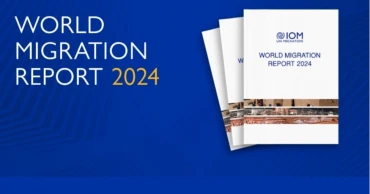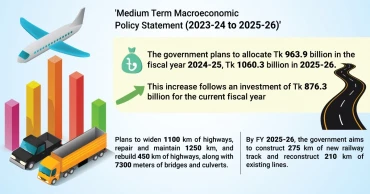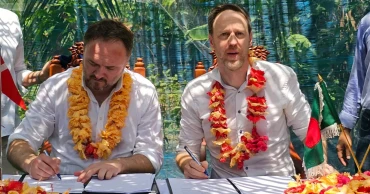economic growth
Bangladesh should focus both on quantity, quality of its economic growth: South Korea
Highlighting Bangladesh's great potential, South Korean Ambassador to Bangladesh Park Young-sik on Sunday said the post-LDC graduation phase in Bangladesh will require considerable efforts from both the government and the private sector to overcome a lot of challenges which the country will face in the coming years.
"Graduation from LDC means that Bangladesh should focus not just on the quantity, but on the quality of its economic growth," he said, noting Bangladesh-Korea growing economic cooperation.
The quality of economic growth must be driven by innovation, knowledge and technology-areas where foreign companies can make substantial contributions, said the ambassador while speaking at a seminar.
Looking to the future, he said, Bangladesh is marching towards graduation from the LDC status in 2026.
"This journey presents both immense opportunities and challenges," the envoy said, noting that Bangladesh has showed great potential, as evidenced by the tripling of Bangladesh’s per capita income over the last decade. However,
The seminar was organised by the Embassy of the Republic of Korea and the Foreign Investors’ Chamber of Commerce and Industry (FICCI) titled "Strengthening Bilateral Trade And Investment Through The Korea-Bangladesh EPA."
Commerce Secretary Mahbubur Rahman spoke at the seminar as the chief guest.
FICCI leaders including Vice President Yasir Azman and Executive Director Nurul Kabir were present.
He emphasised that Korea has always been invested in Bangladesh and will continue to be so, even without FTA - Free Trade Agreement.
South Korea's cenbank cuts borrowing costs to nurse sluggish economy
"Korea is not India, China or the US; we have no strategic interests beyond our economic cooperation," Young-sik said.
He said both countries are currently discussing the initiation of negotiations for the bilateral Economic Partnership Agreement (EPA).
"If concluded, this EPA will significantly enhance bilateral trade and investment in ways that benefit both nations. It is my sincere hope that bilateral EPA negotiations will be soon concluded in a mutually way," said the envoy.
Korean companies have been a long standing partner of Bangladesh, contributing significantly to the growth and success of the RMG industry.
"In recent years, we have witnessed remarkable developments in diversifying areas of cooperation beyond the RMG, particularly in manufacturing and infrastructure," said the ambassador.
Over the last fifty years, collaboration in the RMG sector has been a driving force behind the bilateral relations.
Dr Anisuzzaman for persistent diplomatic engagement with S Korea
"It is my strong hope and I believe that the bilateral EPA could serve as the motor engine to elevate our partnership to new heights in the next fifty years," Young-sik said.
The ambassador said Bangladesh needs foreign direct investment.
However, FDI of Bangladesh is the lowest in terms of the GDP ratio. Bangladesh is 0.75%, while India is 1.7% and Vietnam is 4.7%.
"In this regard, I would like to reiterate the importance of why business environment of Bangladesh should be improved," said the Ambassador.
He said Bangladesh must recognise that its economic structure of protecting the domestic industry with high tariffs should be reformed in a way to open the market.
If domestic production costs remain higher than those of imported goods, foreign companies do not feel the real necessity of investing in Bangladesh, he said.
7 months ago
Only an elected government can drive real economic growth: Abdul Awal Mintoo
Prominent businessman and BNP leader Abdul Awal Mintoo has said that a legitimately elected government is crucial for fostering real economic growth, as it remains accountable to people and prioritises their welfare.
Speaking in an interview with UNB, Mintoo criticised the introduction of a forced electoral system by the Awami League, claiming that it led the party away from its commitment to public welfare.
He alleged that the Awami League engaged in bank fraud and illicitly transferred money abroad due to a loss of confidence in people.
"Political parties can learn from the downfall of autocratic regimes in Bangladesh. No party should attempt to establish autocratic rule or conduct an election without voters in the future," said Mintoo, who is also the Vice Chairman of BNP.
Elected government crucial for economic stability and public trust: Abdul Awal Mintoo
He described the widespread discrimination in Bangladesh, citing last year’s student movement against job quota discrimination as an example. "Discrimination exists across various sectors of society, including the education system."
In the absence of an elected government, Mintoo said, disparities have emerged in crucial areas such as healthcare, education, resource allocation and citizen opportunities.
Bangladesh Bank Governor has assured liquidity crisis resolution for pvt banks: Abdul Awal Mintoo
He pointed out that many schools in Bangladesh suffer from a shortage of skilled teachers, which negatively impacts students' ability to acquire essential skills. "In today's competitive job market, skills are crucial, yet the government has shown little concern for this matter," Mintoo said.
He stressed that students, regardless of whether they live in rural or urban areas, deserve quality education in government institutions.
But the primary and secondary education sectors suffer from mismanagement, with teachers more involved in politics than in their professional duties. "Who will ensure quality education if teachers are preoccupied with political activities?" asked Mintoo, the former president of the Federation of Bangladesh Chambers of Commerce and Industry (FBCCI).
"Once a nation is well-educated, discrimination can be eradicated, as we have seen in Western countries, where quality education for all has been prioritised," he said.
Mintoo asserted that the primary objectives of an elected government should be to eliminate discrimination and ensure equal rights in asset distribution, as well as equitable access to education, healthcare and financial inclusion.
In response to a query, Mintoo said that when the BNP and Awami League previously assumed power through neutral elections, they did not cause harm to the country.
Regarding Bangladesh’s progress in achieving the Sustainable Development Goals (SDGs), he stated that transparent and accurate data on development is essential. "If development is measured using manipulated data, it will ultimately be detrimental to the country," he warned.
Mintoo also criticised the influence of academics and intellectuals in policymaking, arguing that many lack practical knowledge of Bangladesh's socio-economic context. "Their policies have yet to produce the desired results," he said.
He also criticised Bangladesh Bank's tight monetary policy, stating that reducing money circulation is ineffective under current conditions, given the fluctuating exchange rate, high energy costs, and wealth disparity.
"A balanced policy is required to generate new assets, expand investment, and create employment opportunities," he suggested.
According to Mintoo, such measures would enhance people's purchasing power, stabilise inflation and support the manufacturing sector’s growth.
He claimed that many business figures and politicians associated with the autocratic government have amassed vast wealth through bank fraud and extortion, making them largely unaffected by inflation and rising commodity prices. "But common people and small traders are severely impacted by soaring inflation and high interest rates on bank loans," he said.
"The government must facilitate low-cost investment funds and employment generation while ensuring affordable gas and electricity to sustain economic growth," said Mintoo.
He said, “An unelected government lacks the vision and legitimacy to implement such policies effectively. To achieve meaningful reform, a strong government must be established through a participatory election."
9 months ago
Japan reaffirms commitment to support Bangladesh’s reform agenda and economic growth
Japan will support Bangladesh's reform agenda, and its investors would continue to stay in Bangladesh to help boost the country's economic developments, outgoing Japanese ambassador to Bangladesh Iwama Kiminori said on Wednesday.
The Japanese envoy made the comments during a farewell call on Chief Adviser Professor Muhammad Yunus at the State Guest House Jamuna in Dhaka.
Ambassador Kiminori praised the leadership of Professor Yunus and added that his government would cement ties with Bangladesh in three pillars of Japanese engagements, which include peace and stability, economic cooperation, and human-to-human interactions.
"We'll do our best to support the three pillars," Kiminori said, reiterating Tokyo's "strong support" for the reform initiatives undertaken by the Interim Government in areas including elections.
Professor Yunus thanked the outgoing ambassador for their contribution to the Bangladesh-Japan relationship. He also lauded the ties between the two countries.
"The relationship has always been very strong," the Chief Adviser said.
He called for more Japanese investment in Bangladesh as his government was carrying out vital reforms to attract more foreign direct investment in the country.
"The presence of Japanese investors in Bangladesh sends a good message for us," he said.
The Japanese envoy said, "not a single Japanese company has withdrawn" from Bangladesh after the Jully-August mass uprising.
"They are willing to stay in the country," he said.
General amnesty if fake freedom fighters apologise: Farooq-e-Azam
He extended an invitation from Nikkei to an annual conference in Japan where the Japanese Prime Minister is expected to speak.
He said the Chief Adviser could meet chief executives of top Japanese companies during the conference and invite them to invest in Bangladesh.
The Japanese ambassador also appreciated the Chief Adviser's move to hold an international conference on the Rohingya issues, saying Tokyo strongly supports the meeting.
The Chief Adviser reiterated his call to create a UN-guaranteed safe zone in Myanmar's western Rakhine state where the displaced communities can temporarily be relocated before they return to their homes once the conflict is over.
Lamiya Morshed, principal coordinator on SDG Affairs and a senior secretary of the government, was also present during the meeting.
1 year ago
Migrant remittances now outpace foreign investments in developing countries: IOM report
International migration remains a driver of human development and economic growth, highlighted by a more than 650 percent increase in international remittances from 2000 to 2022, rising from USD 128 billion to USD 831 billion, according to a new global report released today.
The growth continued despite predictions from many analysts that remittances would decrease substantially because of COVID-19.
The International Organization for Migration (IOM) launched the World Migration Report 2024, which reveals significant shifts in global migration patterns, including a record number of displaced people and a major increase in international remittances.
IOM Director General Amy Pope formally released the report in Bangladesh, which stands at the "forefront of migration" challenges, including emigration, immigration and displacement.
"We hope the report inspires collaborative efforts to harness the potential of migration as a driver for human development and global prosperity," DG Pope said.
By choosing Dhaka as the report's launch site, IOM not only highlights the country's efforts in supporting vulnerable migrants and fostering pathways for regular migration but also recognizes Bangladesh's important role in shaping global migration discourse and policy, IOM said.
As a Global Compact for Safe, Orderly, and Regular Migration Champion country, Bangladesh has demonstrated a strong commitment to addressing migration issues and implementing policies that safeguard migrants' rights, it said.
Read more: Global actors pledge to collaborate on transformation of Bangladesh agriculture
This proactive engagement aligns with IOM's strategic objectives, making Bangladesh an ideal location to launch the 2024 World Migration Report.
Foreign Minister Dr Hasan Mahmud said as one of the GCM champion countries, Bangladesh will not only continue to act upon the pledges it has made for its domestic context but would also take up emerging issues and challenges pertaining to migration and development for informed deliberations at the international level.
“The World Migration Report 2024 helps demystify the complexity of human mobility through evidence-based data and analysis,” Pope said at the launch.
“In a world grappling with uncertainty, understanding migration dynamics is essential for informed decision-making and effective policy responses, and the World Migration Report advances this understanding by shedding light on longstanding trends and emerging challenges.”
Of that 831 billion in remittances, 647 billion were sent by migrants to low and middle-income countries. These remittances can constitute a significant portion of those countries' GDPs, and globally, these remittances now surpass foreign direct investment in those countries.
Highlighting key findings, the report reveals that while international migration continues to drive human development, challenges persist.
Read more: UK Minister for Indo-Pacific arrives Tuesday on two-day visit
With an estimated 281 million international migrants worldwide, the number of displaced individuals due to conflict, violence, disaster, and other reasons has surged to the highest levels in modern-day records, reaching 117 million, underscoring the urgency of addressing displacement crises.
Migration, an intrinsic part of human history, is often overshadowed by sensationalized narratives.
However, the reality is far more nuanced than what captures headlines.
Most migration is regular, safe, and regionally focused, directly linked to opportunities and livelihoods.
Yet, misinformation and politicization have clouded public discourse, necessitating a clear and accurate portrayal of migration dynamics.
IOM’s World Migration Report, with its innovative digital tools and comprehensive analysis, aims to help dispel myths, provide critical insights, and inspire meaningful action in addressing the challenges and opportunities of human mobility.
This launch is part of IOM Director General’s first three-day visit to Bangladesh.
Chief of IOM Mission in Bangladesh Abdusattor Esoev, former Foreign Secretary Shahidul Haque, senior government officials and diplomats stationed in Dhaka were present at the report launching ceremony.
Read more: UK Minister for Indo-Pacific in Dhaka to ‘strengthen’ economic, security, migration partnership with Bangladesh
1 year ago
Govt plans Tk 2000 billion investment in transport and communication for next two fiscals
The government plans to substantially increase public investments across key sectors such as road, rail, bridge, shipping, civil aviation, and telecommunications. These initiatives are strategically aimed at transforming Bangladesh into an upper middle-income country by 2031 and a smart developed country by 2041.
According to the 'Medium Term Macroeconomic Policy Statement (2023-24 to 2025-26)', the government plans to allocate Tk 963.9 billion in the fiscal year 2024-25, escalating to Tk 1060.3 billion in 2025-26. This increase follows an investment of Tk 876.3 billion for the current fiscal year, emphasising a significant boost in funding for various development programs.
The policy document highlights the critical role of an integrated and cost-effective transport and communication system in fostering economic growth, enhancing trade, and ensuring social integration. It states that an efficient transport and logistics system is essential for smooth supply chain management and to effectively compete on a global scale.
Transport strike called off after 12 hrs in Ctg
Specifically, the Road Transport and Highways Division is implementing projects to establish an advanced and sustainable road transport system, including the construction of multi-lane highways, elevated expressways, and new bridges.
These efforts are complemented by plans to widen 1100 km of highways, repair and maintain 1250 km, and rebuild 450 km of highways, along with 7300 meters of bridges and culverts.
In Dhaka city, the government is focusing on reducing traffic congestion by advancing the metro rail lines, a move poised to significantly improve urban mobility.
The railway sector is also undergoing transformation under a 30-year master plan aimed at making it a dependable, affordable, modern, and people-friendly mode of transport. Initiatives include connecting every district with a railway network, upgrading tracks, and modernising the signaling system. By FY 2025-26, the government aims to construct 275 km of new railway track and reconstruct 210 km of existing lines.
The document also outlines ambitious plans for the water transport system, noting its importance in the integrated multi-modal transport framework. The Ministry of Shipping is executing extensive programs for the enhancement of inland waterways, seaports, and land ports, along with significant dredging efforts to maintain river navigability.
Extortion in transport sector will never stop completely: Quader
Amidst rising demand for air travel, both domestically and internationally, the Ministry of Civil Aviation and Tourism is undertaking projects to expand passenger handling capacities and enhance facilities at airports. These upgrades are part of a broader strategy to position Bangladesh as a regional hub for international passenger transport.
These comprehensive plans not only aim to modernize Bangladesh's infrastructure but also serve as a cornerstone for the country's ambitious economic development goals.
1 year ago
Hasina’s return to power will be welcomed in Global South: Policy analyst Kugelman
Director of the South Asia Institute at Wilson Center in Washington, D.C. Michael Kugelman has said in South Asia and the broader Global South, Bangladesh Awami League President Sheikh Hasina's return will be welcomed.
He cited her focus on economic growth, connectivity, nonalignment, climate change, global peacekeeping and hosting of Rohingyas.
Also read: Bad blood will linger between Dhaka and the West but Hasina’s return will be viewed more positively in the region: South Asia policy analyst Kugelman
"Easy to overlook this with so much focus on what the West thinks," he said.
Within hours after Bangladesh’s election result was declared, the Indian, Russian, and Chinese envoys all extended their congratulations to Prime Minister Sheikh Hasina, Kugelman said.
Also read: ‘US wanted to act proactively to send tough message’: Kugelman
"If anyone is surprised by this, there’s no reason to be. They all (not just India) have long viewed her as a key partner," he shared on X, formerly known as Twitter.
"And guess what other country’s ambassador has now congratulated Hasina? Pakistan. Perhaps the only country in South Asia that might be a bit uncomfortable about her return. But still willing to accept the election result," Kugelman said in a separate message posted from his verified X account.
Also read: AL retains significant level of support because of success stories, says South Asia policy analyst Michael Kugelman
1 year ago
Denmark committed to support Bangladesh’s aspirations for climate-oriented economic growth: Danish Minister
Danish Minister for Development Cooperation and Global Climate Policy Dan Jannik Jørgensen on Wednesday signed an agreement in Bagerhat to extend the Local Government Initiative on Climate Change (LoGIC) project for two years from June 2023 to June 2025.
Danish Ambassador to Bangladesh Winnie Estrup Petersen and UNDP Resident Representative Stefan Liller were present.
With a funding support of 40m Danish Kroner (USD 5.6m approximately) from the Danish government, the extension phase of LoGIC will be implemented in two districts of the Chattogram Hill Tracts (CHT) – namely Rangamati and Bandarban.
Also Read: Bangladesh, Denmark launch action plan to strengthen partnership on green transition
The purpose is to strengthen communities’ resilience to the impact of climate change through locally-led adaptation strategies.
The dignitaries from Denmark, along with representatives of UNDP and UNCDF, visited Mongla in Bagerhat to observe and understand the impact of climate change and how both agencies are building climate resilience through innovative and locally-led solutions.
Minister Jannik Jørgensen, during his visit to climate-affected areas in Mongla took note of the adaptive measures taken by the affected communities to strengthen their resilience against climate change.
Also Read: Bangladesh, Denmark joint action plan for 2023-2028 to be launched soon
He said Denmark values the strong and longstanding bilateral relation with Bangladesh.
"Recognising that Bangladesh is at the forefront of the climate crisis, Denmark is committed to supporting Bangladesh’s aspirations for climate-oriented economic growth and green transition in the years of graduation from the group of LDCs. Denmark is also one of the few development partners that have engaged long term in the CHT, most recently with a focus on climate resilience of communities.” Dan Jannik Jørgensen added.
Also Read: Bangladesh, Denmark sign Tk 474 crore framework agreement to implement dev programme
Winnie Estrup Petersen, Danish Ambassador to Bangladesh, said, “Given the significant climate vulnerability of the region, Denmark will continue to support UNDP and UNCDF in the CHT through LoGIC. This model strengthens the national fiscal transfer systems for the channelling of climate adaptation funding to local governments and ensures institutional and financial sustainability.”
Bangladesh is often cited as one of the world’s most climate-vulnerable nations, and it is the poor who are disproportionately affected, said Stefan Liller, Resident Representative of UNDP Bangladesh.
Also Read: Danish Minister Dan Jørgensen in Dhaka
"As such, we must focus on increasing communities' resilience to the impact of climate change. To this end, we here at UNDP, Bangladesh continue to work on mainstreaming climate change into local level planning and financing processes by blending scientific knowledge with local expertise to identify climate risks and support effective adaptation measures,” Stefan Liller mentioned.
In 2016, the government of Bangladesh (GoB), the European Union (EU), and the Government of Sweden, together with UNDP and UNCDF, jointly designed the ‘Local Government Initiative on Climate Change’ (LoGIC) project to develop a mechanism to deliver climate finance to the most vulnerable households and local government institutions for building resilience and promoting local action on climate change adaptation at scale.
2 years ago
Budget sets 7.5 percent annual economic growth, inflation at 6 percent
The proposed budget of Bangladesh in the fiscal year 2023-24 has set an estimated Gross Domestic Product (GPD) worth of 50.06 lakh crore with a 7.5 percent annual growth.
The inflation target was set to 6 percent which is now 9.28 percent in the proposed budget.
The 7.5 percent growth projection could be deemed as ambitious given the uncertainties in the global economy and various other challenges at home.
Finance Minister AHM Mustafa Kamal explained his position on why he is expecting higher growth this time despite the economic pressures.
Read more: Finance Minister unveils Tk 761,785 crore national budget
“We expect to return to a higher growth trajectory and achieve a 7.5 percent GDP growth, by way of investing in the productive sectors and stimulating productivity and domestic demand,” he said.
Kamal focused on investment in the 100 special economic zones and completing ongoing mega-projects to achieve the GDP target.
In FY19, Bangladesh achieved a record 8.15 percent GDP growth. Then came the pandemic. The finance minister set a growth target of 8.2 percent in FY20, but the actual growth achieved was 3.45 percent, the lowest in several decades.
The growth rate increased to 6.94 percent in FY21 after recovering from pandemic effects. The GDP growth further increased to 7.1 percent in FY22.
Read more: Budget FY23-24: Focus should be on tackling macroeconomic challenges, says Dr Atiur Rahman
2 years ago
Bangladesh can draw more investment if corruption remains less prevalent: Peter Haas
US Ambassador to Bangladesh Peter Haas today (March 21, 2023) said his country is committed to working with Bangladesh to eliminate corruption – enabling Bangladeshis to enjoy lives of dignity and drawing more international trade and foreign investment.
“If Bangladesh can assure citizens and investors that corruption is less prevalent here than in other markets, it will attract more investment and help the country continue on the path of economic growth,” he said.
Ambassador Haas made the remarks at an event, titled “Call to Action Against Corruption Summit”, at a Dhaka hotel, organized by Centre for Governance Studies (CGS) and Center for International Private Enterprises.
The US ambassador said corruption exists, to one degree or another, in every corner of the globe, and they are all too familiar with what it looks like.
Read More: Excited to see more Bangladeshi students are choosing US: Peter Haas
“It’s trying to get a driver’s license and having to pay ‘speed money’. It’s knowing that if you want a passport appointment, it’s going to cost you extra. It’s needing to bribe the right official to register a plot of land you just purchased,” Haas said.
Corruption is a parasite that feeds on the resources of a society and drains it of its strength and can devastate every level of business and government, he said.
“Sadly, some notorious scandals have occurred in my own country,” said the US ambassador.
Yet, he said, exposing corruption and holding perpetrators accountable have catalyzed economic growth in the United States and elsewhere.
Read More: New US Ambassador Peter Haas arrives in Dhaka
“When societies exert such efforts, they prosper. I am confident this can be the case here in Bangladesh, as well, and the United States is eager to help,” he said.
Under President Biden, the US government has established the fight against corruption as a core national security interest, he added.
“We support initiatives that help Bangladeshi businesses meet international standards and regulations, making them more competitive in the global market,” said the envoy.
“By promoting ethical business practices, we can create a more level playing field for businesses of all sizes and encourage more foreign investment,” he added.
Read More: Peter Haas nominated next US Ambassador to Bangladesh
The US Agency for International Development, USAID, has partnered with Bangladesh’s Registrar of Joint Stock Companies to launch an online registration process for new businesses.
This makes registering new businesses more transparent, faster, and more affordable, Ambassador Haas said.
USAID has also worked with the Bangladesh National Board of Revenue to establish authorized economic operators. This endeavour empowers the private sector, instead of the government, to release shipments at ports, he said.
As a result, Haas said, the process has become more transparent and raised the level of trust between the private sector and the government.
Read More: Prevent corruption in every sector: President to ACC
The US Department of Commerce’s Commercial Law Development Program (CLDP) works with the Private Public Partnership Authority Bangladesh to conduct workshops to improve the legal and business environment of Bangladesh.
CLDP also works with Dhaka North City Corporation (DNCC) to improve municipal governance by improving fiscal transparency. Under this program, CLDP invited over a DNCC delegation, including the mayor, to Miami in January.
The US Department of Justice trains investigators and attorneys in the Anti-Corruption Commission on topics such as how to investigate and prosecute money laundering, how to use electronic evidence, and how to investigate financial crimes.
“It has also fostered a relationship between Bangladesh’s Financial Intelligence Unit and the International Anti-Corruption Coordination Centre,” Haas said.
Read More: All-pervasive corruption by AL destroys economy: Fakhrul
“The United States is committed to holding corrupt officials accountable for their actions. This can take various forms,” said the ambassador.
Just as US laws hold American citizens and businesses accountable for corrupt practices, there are US laws and penalties that apply to non-citizens who use corrupt practices in violation of the laws.
“What can the Bangladeshi government do to reduce corruption? It could think about ways to empower institutions to tackle corruption and promote transparency and accountability in governance and business,” he said.
One idea is to reduce the amount of cash that officials handle by replacing cash-based financial transactions with the government with online transactions, Haas said.
Read More: Power tariff being raised frequently to manage corruption: Fakhrul
“Citizens could pay bills, fines, and taxes electronically. Such a process would minimize the opportunity for bureaucrats to overcharge or misplace public funds into their own pockets,” he said.
Haas recognized the important role a vibrant civil society and free media play in investigating and exposing instances of corruption.
Bangladesh has many advantages that potential investors would find attractive, he said. “But as American business leaders tell me: multi-national firms have options on where they invest.”
They will choose whichever country has the lowest levels of corruption, the fewest bureaucratic obstacles, the greatest respect for rule of law, and the best logistics infrastructure for their business, he added.
Read More: BNP's complaints about corruption 'laughable': Hasan Mahmud
2 years ago
World Bank a key partner of Bangladesh’s economic growth: Finance Minister
Finance Minister AHM Mustafa Kamal on Sunday praised the World Bank for its continued support towards Bangladesh’s development.
He said Bangladesh's growth has increased by 74 times since 1972, and the World Bank had a role to play behind it.
“After independence, the country's GDP growth was only $6.3 billion, which has now increased to $465 billion,” he said.
Kamal said this while speaking as the chief guest as the World Bank and Bangladesh celebrated its 50 years of partnership at the Bangabandhu International Conference Center (BICC) in the capital on Sunday.
Also Read: WB cuts Bangladesh growth target by 0.9 percent to 5.2 percent
The Finance Minister also said that Bangladesh is currently the 35th largest economy, and the poverty rate has come down to 20 percent, per capita income increased to $2,824 and average life expectancy increased to 73 years.
Also read: World Bank managing director to arrive in Dhaka Saturday
Highlighting the future plans, the Finance Minister said, “Our next target will be to turn Bangladesh into an upper-middle income country by 2031, and a Smart Developed Bangladesh in 2041.”
World Bank Managing Director (Operation) Axel van Trotsenbur, World Bank South Asian Region Vice President Martin Riser, Economic Relations Division Secretary Sharifa Khan, and World Bank Country Director for Bangladesh and Bhutan Abdoulaye Seck, among others, spoke at the function.
2 years ago



















